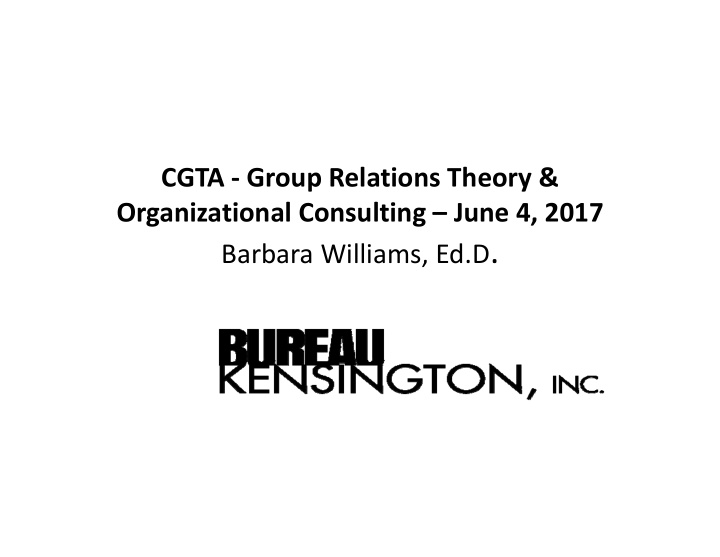



CGTA ‐ Group Relations Theory & Organizational Consulting – June 4, 2017 Barbara Williams, Ed.D .
Purpose of the discussion • Explore meanings of the terms unconscious functioning, transference and projective identification, valency, basic assumption & work groups and their applicability to organizational consulting • Some limitations of this methodology to organizational consulting.
1. Wilfrid Bion’s Contribution Bion's attention was on the unconscious properties of the group as a whole. The group had its own Unc dynamics and was not simply an aggregate of individuals or individual Unc. He was viewing the behaviour of his ward, from the point of view of the intra‐group tensions that emerged, not as the result of personal illnesses but as a collusion by a group with the staff requirements of a hospital where the staff are to be well and self‐disciplined and patients are to be ill and disordered". In Experiences in Groups, Bion makes explicit the significance of the unconscious in group behaviour, the stance he was working from during the Northfield Experiment was to make hypotheses about unconscious functioning at the level of the group.
2. The group relations methodology • Transference refers to the ways our internalised images of authority figures and those who take authority roles derived from our childhood experiences push us toward recreating familiar relationships in ways that can obscure the complexity of the people in our lives. • Projective identification refers to the way we unconsciously attempt to coerce others through covert actions to become the people we need them to be for our own unconscious and neurotic reasons. This unconscious coercion occurs both between individuals, and within and between groups. • Holding to strict boundaries of time, task, space, and role, containment enables people to cope with anxiety, aggression, confusion, and new learning evoked by the lack of familiar guide‐posts. • Basic‐assumption to help us think about predominant Unc projective identifications and transferences in groups • Valency refers to the propensity for individuals to contribute to Ba. The Unc processes in groups ‘pulls’ on old histories and those are deposited and made use of by the group.
Basic Assumption & Works Groups • Basic‐Assumption Dependency Group • Pairing Basic‐Assumption Group • Fight/Flight Basic‐Assumption Group & Work groups
3. What the GR theory helps me do with organizations 1. Look for requisite boundaries characteristic of High‐ Functioning Work‐Groups 2. Consider how the organization might be regressogenic or employing Basic assumptions 3. Notice the ways in which the the organization deals with authority? Their own and me as an authority. What is the transference? 4. Consider how much containment I am asked for and is needed. 5. What sorts of ‘easy’ solutions are sought? 6. How do questions of ‘injustice’ – sexism, racism, harassment – get named and addressed?
The limits • I have a HR/leadership/strategic planning background so I rarely get specifically asked to consult psychoanalytically • Organizations have specific challenges for which expertise may be required – this is not always a Ba problem, but one that may require a specific skill set • There is a psychological resistance to these ideas in some sectors – so what is addressed is only what can be ‘seen’ or the latest quick answers • What else?
Recommend
More recommend